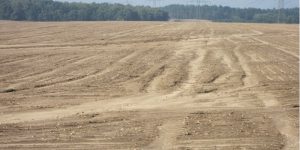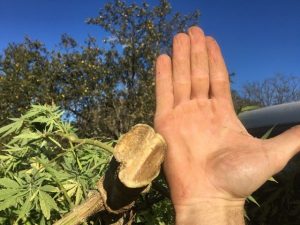Humans have developed an extraordinary capacity to greatly alter our landscape. Does that mean that we should? Where does our responsibility lie as visitors on this magnificent planet?
As usual, we learn from the deep and extraordinary intelligence of nature.
Disruption does occur on a broad spectrum in our natural world. It could be as benign as a songbird unwittingly pruning a branch off of a blueberry bush as it pulls off a berry. It could be as destructive as a Class 5 hurricane laying waste to hundreds of miles of habitat and the creatures that live within it. Given this wide range, it can be challenging to determine what appropriate human behavior is, and you could certainly make the case that whatever we’ve developed the ability to do through our evolution – be it digging with our fingernails, with a shovel, or with a petroleum-fueled bucket – falls within the range of “natural.”
Still, at Bravo we try to look at the overall picture of the frequency and impact of such events as we navigate towards a more harmonious co-creation with Earth.
It’s well accepted that the increasing level of carbon in our atmosphere is contributing to more chaotic and extreme weather events. It’s not going to be enough to stop releasing carbon into the atmosphere, particularly because there is so much already “baked in the cake,” as they say. We need to be actively removing existing carbon from the skies, and that’s where we can lean on the incredible carbon-storing capacities of the soil. How does the carbon get from there to here? By way of the plants, of course! If trees act as the lungs of the planet, we can consider smaller plants and groundcover as the capillaries of those organs, just as critical in maintaining healthy breathing.
Unfortunately, the turning over of topsoil removes that vegetation and thus the critical protection for the delicate microbial ecosystem that lives beneath the surface. These are the lifeforms that are responsible for interacting with the plants’ roots, facilitating the exchange of carbon and nutrients. It is imperative that these intimate relationships are allowed to flourish so that the lines of communication between the air and ground remain open.

An over-worked soilbed becomes devoid of life and gets caught in the vicious cycle of continued degradation through increased chemical inputs.
Does this mean that we should never till? Certainly not. As previously stated, disruption is natural and can provide an opportunity for a new plant to grow or a new paradigm to take root. But these events should be limited as much as possible and considered more as rare “hundred-year events.” Problems arise with repeated and aggressive tilling that never allows the life in the soil to regenerate and reestablish. It’s akin to repeatedly poking a wound and never allowing it to heal, and it creates a barren landscape that looks more like Mars than the verdant Earth we depend upon. Exposed topsoil becomes vulnerable to drying out and blowing away, not only releasing the carbon that is stored there, but also limiting its ability to sequester more.

That’s some incredible carbon content. The hemp stalk is pretty amazing too.
The cannabis plant, and hemp in particular, is remarkable for the growth that it puts on over the course of a single growing season. It is not uncommon for plants to reach heights of 6′ or more with stalks of 2″ in diameter during even our shortish Vermont summers. This rapid and pronounced growth means that hemp grown in a no-till environment can contribute to atmospheric carbon reduction in a meaningful way.
We grow about 500 hemp plants at Bravo, which puts us on the smaller boutique side of farming. It’s hard to quantify exactly what that means in the grand scheme of things against what sometimes feels like a runaway train to extinction. What we do know is that it feels like the way to us and as more and more farmers and consumers become savvy to the importance of keeping the soil structure intact and protected, we’ll be happy to consider our farm as one small and important regenerative node of this supra-organism called Earth.
As we realize that human wellness is inseparable from our planet’s health and we make choices that encourage the profound healing ability of this Earth, it seems that we’ll have the chance to breathe more freely and deeply. Wouldn’t that be something?




